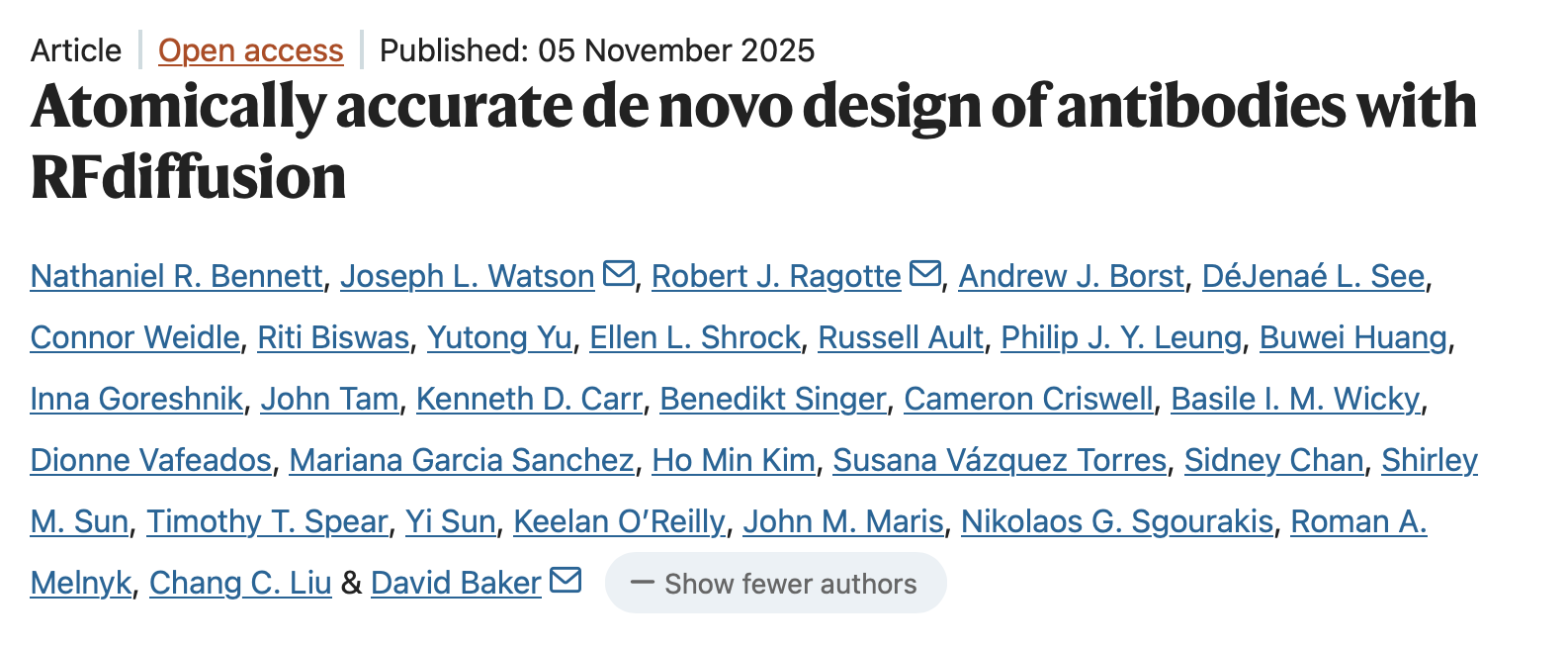Olivier Elemento, Director of Englander Institute for Precision Medicine at Weill Cornell Medicine, shared a post on LinkedIn:
“What if we could design antibodies from scratch, atom by atom, targeting the exact spot on a disease protein we want to hit?
David Baker‘s team at the Institute for Protein Design, University of Washington just published a Nature paper showing this is now possible. Using AI, they’ve achieved the first atomically accurate de novo design of antibodies – creating them from scratch with no starting antibody to optimize.
The breakthrough addresses a fundamental limitation in antibody therapeutics. While antibodies dominate protein drugs (160+ approved globally, $445B market), discovering new ones has relied on immunizing animals or screening massive libraries. You can’t control where these antibodies will bind.
Precision targeting at the atomic level
The team fine-tuned RFdiffusion – a deep learning model that generates protein structures – for antibody design. They trained it on thousands of antibody-antigen complexes, teaching it to design the binding loops.
Users specify which target amino acids they want to bind, and RFdiffusion generates designs for that spot.
Atomic accuracy confirmed
They designed antibodies targeting influenza, C. difficile toxin, SARS-CoV-2, and other proteins, then solved cryo-EM structures to verify accuracy.
The influenza antibody matched the design almost perfectly: 1.45 angstroms deviation – roughly a single atom’s diameter. Cryo-EM showed all six binding loops were designed with near-atomic accuracy.
From computer to clinic
Initial designs bind with moderate affinity (tens to hundreds of nanomolar) – the computational method can’t yet create strong binders. Continuous evolution in yeast improved binding roughly 100-fold to single-digit nanomolar, maintaining the intended binding site.
Computational design achieves atomic precision but still needs biological optimization for therapeutic-grade affinity. The goal is eventually doing everything in silico.
Why this matters
This is AI solving a hard problem with direct therapeutic applications. Specifying where your antibody binds opens strategies that weren’t possible before. Block a protein-protein interaction? Design for that interface. Hit a conserved region across viral variants? Design for that. The implications extend to antibody-drug conjugates, where precise targeting determines both efficacy and safety.
They demonstrated this with a challenging cancer target: a PHOX2B peptide presented on MHC in neuroblastoma, addressing patient populations that existing therapies can’t reach.
Success rates are still low (0-2%), but AlphaFold3 can predict which designs will work. The pipeline is open source on GitHub.
I believe this is the first demonstration that we can design therapeutic antibodies entirely in silico with atomic-level precision.”
Title: Atomically accurate de novo design of antibodies with RFdiffusion
Authors: Nathaniel R. Bennett, Joseph L. Watson, Robert J. Ragotte, Andrew J. Borst, DéJenaé L. See, Connor Weidle, Riti Biswas, Yutong Yu, Ellen L. Shrock, Russell Ault, Philip J. Y. Leung, Buwei Huang, Inna Goreshnik, John Tam, Kenneth D. Carr, Benedikt Singer, Cameron Criswell, Basile I. M. Wicky, Dionne Vafeados, Mariana Garcia Sanchez, Ho Min Kim, Susana Vázquez Torres, Sidney Chan, Shirley M. Sun, Timothy T. Spear, Yi Sun, Keelan O’Reilly, John M. Maris, Nikolaos G. Sgourakis, Roman A. Melnyk, Chang C. Liu, David Baker
Read the Full Article on Nature

More posts featuring Olivier Elemento.
